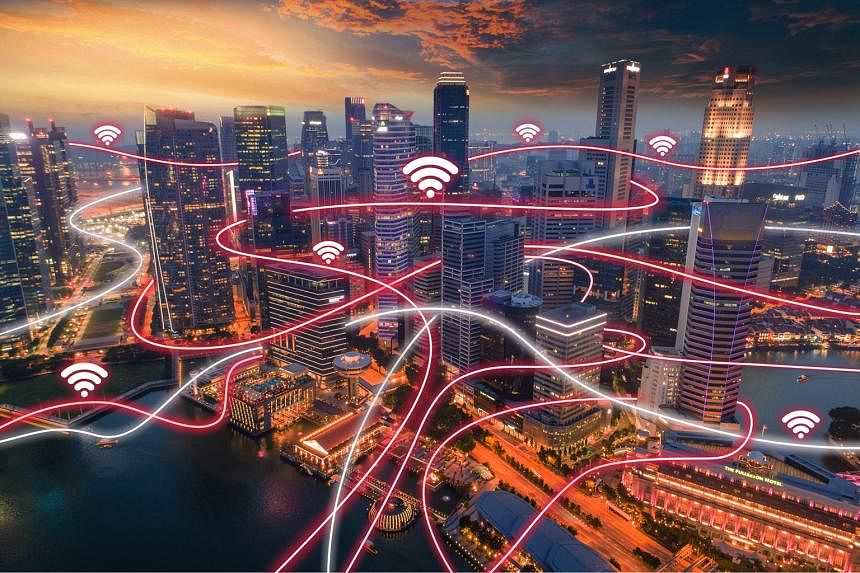In January this year, Kiss92's morning radio duo, Glenn Ong and The Flying Dutchman, sparked a hilarious debate with a simple question: “Would Singaporean men pick Wi-Fi over their wives?” And conversely, “Would Singaporean women pick broadband over their men?”
While wrapped in jest, the recently viral “Wi-Fi or Wifey” and “Broadband or Your Man” exchanges during their The Big Show belie a topic close to every Singaporean’s heart: that we love and rely on Wi-Fi, and the faster it is, the better. The Internet has become not just a convenience but also a necessity, woven deeply into our everyday lives.
So how did Singapore come to be a nation so reliant on and well-served by high-speed Internet? The answer lies in the complex web of infrastructure that hums silently in the background, powering our digital lives. When a TikTok video filmed thousands of miles away becomes an overnight sensation on your smartphone, or when you send an email to a colleague in a different time zone, it is easy to overlook the intricate mechanism that makes global connectivity so seamless.
Where is the Internet? Watch this video to find out how many Singaporeans got it wrong:
Contrary to what many of us believe, the Internet is not an ethereal entity nestled in the "cloud". In reality, it is a network of optical fibre cables, often hidden from view beneath our cities and threading their way across the depths of our oceans. This physical network is what allows near-instantaneous global communication, connecting our digital world in tangible, albeit unseen, ways.
If we depend on the Internet so much, why don’t we know more about it?
Indeed, the majority of our Internet is crafted from cables. When you browse the web, the data is transmitted wirelessly as signals to Wi-Fi routers. However, this wireless transmission ends as soon as it reaches these devices. From there, the routers are interconnected with servers and data centres via a vast network of subterranean optical fibre cables spread across Singapore.
These cables extend far beyond our island. Along the coastlines, landing stations connect these land-based cables to an even more extensive network of cables embedded in the ocean floors. This continuous chain of cables allows data to travel across oceans, bridging continents.

The concept of physical cables stitching together cities and countries might seem antiquated, even quaint. It is a legacy that traces its roots back to 1858 when the first transatlantic telegraph cable was laid out, connecting the US and Europe. Then Queen Victoria sent a 98-word telegram to US President James Buchanan via this cable, which took more than 16 hours to transmit.
Today, we have come a long way from the telegrams our grandparents knew. Instead, our devices can share lengthy Telegram and Twitter messages and high-definition videos instantaneously across the globe. This modern communication is facilitated by more than 500 active and planned undersea cables strung across our planet's oceans and continents.
Singapore plays a vital role in this global network, currently hosting nearly 30 of these cables, linking us to continents as far off as Europe. These cables work relentlessly, transmitting multiple signals across various frequencies concurrently. This method, known as broadband, is akin to a high-speed expressway with numerous lanes. It stands in stark contrast to the era of screechy dial-up Internet, which could be likened to a local road with limited lanes and slow-moving traffic.
Today there are also wireless protocols, such as the prevailing Wi-Fi 6, which act as our digital “sports cars”. They enable us to get on this Internet expressway at higher speeds, making our digital interactions swift and seamless. However, in countries where Internet infrastructure is underdeveloped, the digital “vehicles” face more obstacles and take much longer to navigate, leading to slow or laggy Internet experiences.
How does it happen so easily in Singapore?
Venturing beyond Singapore's borders, you may find yourself frustrated by a noticeably slower Internet experience. Web pages and applications might take longer to load, and YouTube videos might pause to buffer or play at a lower resolution. This difference is hardly surprising, given that Singapore is regularly named one of the world's fastest broadband nations, according to the Speedtest Global Index report by Internet metrics company Ookla.
This global recognition is not an overnight success but rather the result of consistent and progressive advancements in the field. When Singtel unveiled commercial dial-up Internet access to Singapore's consumer market in 1994, many perceived it as a novelty for a niche audience.
Within four years, in 1998, the introduction of broadband Internet promised speeds over 100 times faster than its dial-up predecessor, marking the dawn of a new era. By 2007, with smartphones becoming an everyday essential, the demand for 3G mobile Internet access skyrocketed.

Then in 2013, an ambitious initiative led by the Government and a consortium of companies, including Singtel and Singapore Press Holdings, ensured fibre broadband access points were made available in all households. Coinciding with this infrastructural upgrade was the achievement of islandwide 4G mobile coverage by telcos. This accomplishment meant that high-speed Internet could be accessed on virtually any mobile device, be it laptops, smartphones or tablets, throughout Singapore.
From highway to mega-highway
As the digital landscape evolves, Internet telcos are constantly challenged to offer more robust and high-speed plans to cater to consumers' ever-growing expectations.
For instance, while data plans used to focus on download speeds, the worldwide shift towards remote work has boosted demand for faster upload speeds for activities such as high-fidelity video conferencing and large data file uploads.
And as more employees return to the office, there is also a growing need for businesses to upgrade their bandwidth with new technologies to improve support for multiple users engaging in simultaneous online activities.
In response to these rising demands for new technologies, Singtel launched Singapore’s first symmetrical 10Gbps broadband plan with the newest Wi-Fi 7 protocol in December 2023. Featuring the latest in Wi-Fi technology, this plan offers speeds of up to 10Gbps wirelessly, for both uploads and downloads. That’s 10 times faster than the standard 1Gbps broadband plan most Singaporeans have.
This is in line with the Government's plans to invest $100 million to upgrade home broadband infrastructure to support 10Gbps connections nationwide within the next five years, as announced at Budget 2024 last month.

If a 1Gbps broadband connection is like an expressway, the 10Gbps broadband plan is like a mega-highway with 10 times as many lanes, accommodating a multitude of “vehicles” all at once.
With faster broadband, users would also need better hardware to take advantage of the added bandwidth. That’s where Wi-Fi 7 routers come in, doubling the bandwidth offered by Wi-Fi 5 and 6 routers. Some of the latest smartphones, PCs and tablets already support Wi-Fi 7, with more set to hit the market this year.
Together, these upgrades mean faster speeds, more stability and greater capacity to support more connected devices at the same time.
Why a secured network is just as important
Today, advancements in Wi-Fi technology make our Internet experiences even faster and more secure. But having rapid Internet speed is just part of the equation. The security of our connection is equally, if not more, crucial. After all, unsecured networks and devices can leave us exposed to cybercriminals.
Travelling the broadband expressways in our metaphorical sports car, it is reassuring to know providers like Singtel place a premium on robust security. Their commitment to safeguarding the network from relentless cyber threats means we can surf and shop with fewer interruptions, resting easy that our personal data is well-guarded.

Imagine the chaos if, in the middle of an important virtual business meeting, your connection is hijacked, dropping you out of the meeting and compromising critical confidential information. Or perhaps you are indulging in some online shopping, entering your credit card details into what you believe is a secure website, only to have your data intercepted by a hacker on an unsecured network, who uses it for fraudulent purchases or even sells it on the dark web.
Security add-ons such as Singtel’s Broadband Protect and Security Suite Triple Protect offer an added layer of safety for subscribers. For instance, Broadband Protect safeguards against phishing, malware and botnets, while the Security Suite Triple Protect offers round-the-clock monitoring of personal data, with alerts if data is breached on the Internet. Returning to our digital “sports car”, these features are akin to equipping it with state-of-the-art safety technologies and along with practising good cyber hygiene, can ensure a secure and seamless online experience.
Mr Timothy Hui, senior director, technology strategy and transformation at Singtel, says: “We use the Internet not only for leisure, but to work and learn from home. Many of our appliances at home also depend on Internet connectivity. As such, having a high quality, reliable and secure Internet connection is critical. Relying on a network, such as Singtel's, that serves not only home users but also large companies that run our nation's critical infrastructure and digital services, provides great assurance to users at home. They can also rely on Singtel's 24/7 call centre and efficient on-site support team, should any problems arise.”
So, as we navigate the digital landscape, we ought to remember that it is not our imagination: Singapore's Internet really is faster than the broadband highways in many other countries we might visit. Companies such as Singtel have been laying the foundations, building the infrastructure and maintaining the security measures that make our seamless Internet experiences possible. They are the architects, builders and security guards of our digital highways, ensuring we can enjoy our viral video streams and fire off emails without a hitch.
Find out more about Singtel’s home broadband offerings here.
In partnership with Singtel

